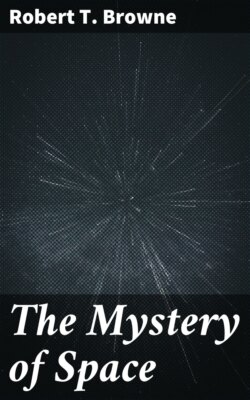Читать книгу The Mystery of Space - Robert T. Browne - Страница 8
На сайте Литреса книга снята с продажи.
ОглавлениеFig. 3.
Fig. 4.
If the plane figure aabb is made to revolve upon its axis of symmetry AB the two arcs, ab and ab will describe a pseudospherical concave-convex surface like that of a solid anchor ring. Above and below, toward aa and bb, the surface will turn outward with ever-increasing flexure till it becomes perpendicular to the axis and ends at the edge with one curvature infinite. Or, the half of a pseudospherical surface may be rolled up into the shape of a champagne glass, as in Fig. 4. In this way, the two straightest lines of the pseudospherical surface may be indefinitely produced, giving a kind of space (pseudospherical) in which the axiom of parallels does not hold true.
The determinative period marks the most important stage in the development of non-Euclidean geometry and certainly the most significant in the evolution of the idea of hyperspaces and multiple dimensionality. Riemann and Beltrami are chief among those whose labors characterize the scope of this period. Their work gave direction and general outline for later developments and all subsequent researches along these lines have been conducted in strict conformity with the principles laid down by these pioneer constructionists. They laid out the field and designated its confines beyond which no adventurer has since dared to pass.
The great importance of the work of Riemann at this time may be seen further in the fact that it not only marked the beginning of a new epoch in geometry; but his pronouncement of the hypothesis that space is unbounded, though finite, is really the first time in the history of human thought that expression was ever given to the idea that space may yet be only of limited extent. Before that time the minds of all men seemed to have been unanimous in the consideration of space as an illimitable and infinite quantity.
The Elaborative Period
The elaborative stage includes the work of all those who, working upon the bases laid down by Lobachevski, Bolyai, SchweikarT and Riemann, have sought to amplify the conclusions reached by them. Among those whose investigations have greatly multiplied the applications of hyperspace conceptions are Hoüel (1866) and Flye St. Marie (1871) of France; Helmholtz (1868), Frischauf (1872), Klein (1849), and Baltzer (1877) of Germany; Beltrami (1872) of Italy; De Tilly (1879) of Belgium; Clifford and Cayley (1821) of England; Newcomb (1835) and Halstead of America.
These have been most active in popularizing the subject of non-Euclidean geometry and incidentally the idea of the fourth dimension. The great mass of non-professional mathematical readers, therefore, owe these men an immeasurable debt of gratitude for the work that they have done in the matter of rendering the conceptions which constitute the fabric of metageometry understandable and thinkable. A glance at the bibliography appended at the end of this volume will give some idea of the enormous amount of labor that has been expended in an effort to translate the most abstract mathematical principles into a language that could easily be comprehended by the average intelligent person.
The characteristic standpoint of this period is the popular comprehension of the hyperspace concept and the consequent mental liberation which follows. For there is no doubt but that unheard of possibilities of thought have been revealed by investigations into the nature of space. An entirely new world has been opened to view and only a beginning has been made at the exploration of its extent and resources.
One of the notable incidents of the early years of this period is the position taken by Felix Klein who stands in about the same relation to Cayley as Beltrami does to Riemann, in that he assumed the task of completing the work of his predecessor. Klein held that there are only two kinds of Riemannian space—the elliptical and the spherical. Or in other words, that there are only two possible kinds of space in which the propositions announced by Riemann could apply. Sophus Lie, called the "great comparative anatomist of geometric theories," carried his classifications to a final conclusion in connection with spaces of all kinds and decided that there are possible only four kinds of three dimensional spaces.
But whether men with peering, microscopic, histological vision shall establish the existence of one or many spaces, and regardless of the mathematic rigor with which they shall demonstrate the self-consistency of the doctrines which they hold, the fact remains that the hypotheses thus maintained, while they may be regarded as true descriptions of the spaces concerned, are, nevertheless, incompatible. All of them cannot be valid. It will perhaps be found that none of them are valid, especially objectively so. The only true view, therefore, of these systems of hyperspaces is that which assigns them to their rightful place in the infinitely vast world of pure mathesis where their validity may go unchallenged and their existence unquestioned; for in that domain of unconfined mentation, in that realm of divine intuitability, the marvelous wonderland of ideas and notions, one is not only disinclined to doubt their logical actuality, but is quite willing to accede their claims.
